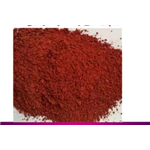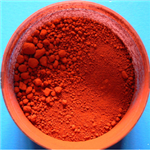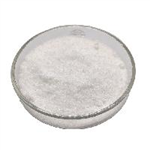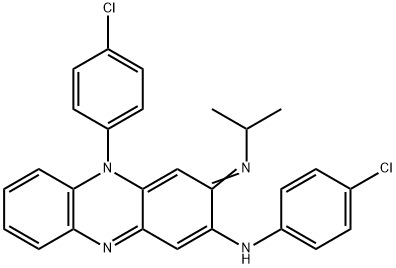- Clofazimine
-

- $14.00 / 1Kg/Bag
-
2023-04-12
- CAS:2030-63-9
- Min. Order: 1Kg/Bag
- Purity: 98%
- Supply Ability: Weekly supply of 1000 KG
- Clofazimine
-

- $56.99 / 1KG
-
2022-02-25
- CAS:2030-63-9
- Min. Order: 1KG
- Purity: 99%
- Supply Ability: 100KG
- Clofaziminum
-

- $16.00 / 1KG
-
2022-02-25
- CAS:2030-63-9
- Min. Order: 1KG
- Purity: 99%
- Supply Ability: 3KGS
|
| | Clofazimine Basic information |
| Product Name: | Clofazimine | | Synonyms: | 2-phenazinamine,3,5-dihydro-n,5-bis(4-chlorophenyl)-3-((1-methylethyl)imino);b-663;b663(pharmaceutical);N,10-Bis[4-chlorophenyl]-2,10-dihydro-2-[[1-methylethyl] imino]-3-phenazinamine;N,5-Bis(4-chlorophenyl)-3,5-dihydro-3-(isopropyliaino)phenazin-2-amine;3-(p-Chloroanilino)-10-(p-Chlorophenyl)-2,10-dihydro-2-(iso-propylimi-no)phenazine;nsc-141046;phenazine,2,10-dihydro-3-(p-chloroanilino)-10-(p-chlorophenyl)-2-(isopropylimi | | CAS: | 2030-63-9 | | MF: | C27H22Cl2N4 | | MW: | 473.4 | | EINECS: | 217-980-2 | | Product Categories: | DESOWEN;Other APIs;Aromatics;Heterocycles;Intermediates & Fine Chemicals;Pharmaceuticals | | Mol File: | 2030-63-9.mol |  |
| | Clofazimine Chemical Properties |
| Melting point | 210-212° | | Boiling point | 616.26°C (rough estimate) | | density | 1.1342 (rough estimate) | | refractive index | 1.6300 (estimate) | | storage temp. | 2-8°C | | solubility | Practically insoluble in water, soluble in methylene chloride, very slightly soluble in ethanol (96 per cent). It shows polymorphism (5.9). | | pka | 8.37; also reported as 8.51(at 25℃) | | color | Yellow to Amber to Dark red | | Water Solubility | 10mg/L(temperature not stated) | | Merck | 14,2373 | | BCS Class | 4/3 |
| Hazard Codes | Xn,Xi | | Risk Statements | 22-36/37/38 | | Safety Statements | 36-26 | | WGK Germany | 3 | | RTECS | SG1578000 | | HS Code | 35040000 | | Toxicity | LD50 orally in mice, rats, and guinea pigs: >4 g/kg (Stenger) |
| | Clofazimine Usage And Synthesis |
| Chemical Properties | Red Solid | | Uses | antiinflammatory, glucocorticoid | | Uses | Antibacterial (tuberculostatic, leprostatic). | | Definition | ChEBI: 3-Isopropylimino-3,5-dihydro-phenazine in which the hydrogen at position 5 is substituted substituted by a 4-chlorophenyl group, and that at position 2 is substituted by a (4-chlorophenyl)amino group. A dark red crystalline solid, clofazimine is an antimyc
bacterial and is one of the main drugs used for the treatment of multi-bacillary leprosy. However, it can cause red/brown discolouration of the skin, so other treatments are often preferred in light-skinned patients. | | Indications | Clofazimine is a weakly bactericidal dye that has some
activity against M. leprae. Its precise mechanism of action
is unknown but may involve mycobacterial DNA
binding. Its oral absorption is quite variable, with 9 to
70% of the drug eliminated in the feces. Clofazimine
achieves significant concentrations in tissues, including
the phagocytic cells; it has a plasma half-life of 70 days.
It is primarily excreted in bile, with less than 1% excretion
in urine. | | Brand name | Lamprene
(Novartis). | | Antimicrobial activity | The mode of action is not fully understood. It has bacteristatic
and weak bactericidal activity against several species of
mycobacteria and some species of Actinomyces and Nocardia.
In-vitro minimum inhibitory concentrations (MICs) are:
M. tuberculosis 0.5 mg/L and M. leprae (assayed in a mouse
model) 0.1–1 mg/L, but these MICs have limited
clinical
relevance as clofazimine shows marked differences in accumulation
in various tissues. Activity against M. leprae is demonstrable
in humans only after 50 days of therapy.
Clofazimine
resistance, although reported, appears to be rare. | | Pharmaceutical Applications | One of a number of substituted iminophenazine dyes originally
synthesized as potential antituberculosis agents. It is
almost insoluble in water. It stimulates various phagocyte
functions including release of free oxygen radicals, but it is
not clear whether this contributes to its antimicrobial activity.
It also has anti-inflammatory properties, attributed to its
ability to inhibit certain patterns of intracellular T-cell receptor-
mediated signaling, making it a useful drug for treating
leprosy reactions and possibly other autoimmune processes. | | Pharmacology | Clofazimine is a substituted iminophenazine that was first proposed for treating leprosy in
1962; however, it entered into medical practice toward the end of the 1980s. The mecha�nisms of its action is not definitively known, although there is the assumption that it can
inhibit the formation of matrixes with DNA, which leads to a delay in the growth of
mycobacteria. Clofazimine exhibits a bactericidal effect between that of dapsone and
rifampicin. Synonym of this drug is lamprene. | | Pharmacokinetics | Clofazimine is well absorbed by the intestine and is taken
up by adipose tissue and cells of the macrophage/monocyte
series, including those in the intestinal wall. It has a very long
half-life (variously estimated as 10–70 days) and is eliminated,
mostly unchanged, in the urine and feces. | | Clinical Use | Clofazimine is given to treat sulfone-resistant leprosy
or to patients who are intolerant to sulfones. It also
exerts an antiinflammatory effect and prevents erythema
nodosum leprosum, which can interrupt treatment
with dapsone.This is a major advantage of clofazimine
over other antileprosy drugs. Ulcerative lesions
caused by Mycobacterium ulcerans respond well to clofazimine.
It also has some activity against M. tuberculosis
and can be used as last resort therapy for the treatment
of MDR tuberculosis. | | Clinical Use | Clofazimine (Lamprene) is a basic red dye that exerts a slow bactericidal effect on M. leprae, the bacterium that causes leprosy. It occurs as a dark red crystalline solid that is insoluble in water. Clofazimine is used in the treatment of lepromatous leprosy, including dapsone-resistant forms of the disease. In addition to its antibacterial action, the drug appears to possess anti-inflammatory and immune-modulating effects that are of value in controlling neuritic complications and in suppressing erythema nodosum leprosum reactions associated with lepromatous leprosy. It is frequently used in combination with other drugs, such as dapsone or rifampin.The mechanisms of antibacterial and anti-inflammatory actions of clofazimine are not known. The drug is known to bind to nucleic acids and concentrate in reticuloendothelial tissue. It can also act as an electron acceptor and may interfere with electron transport processes. The oral absorption of clofazimine is estimated to be about 50%. It is a highly lipid-soluble drug that is distributed into lipoidal tissue and the reticuloendothelial system. Urinary excretion of unchanged drug and metabolites is negligible. Its half-life after repeated dosage is estimated to be about 70 days. Severe gastrointestinal intolerance to clofazimine is relatively common. Skin pigmentation, ichthyosis and dryness, rash, and pruritus also occur frequently. Clofazimine has also been used to treat skin lesions caused by Mycobacterium ulcerans. | | Clinical Use | Multibacillary leprosy (in combination with other anti-leprosy drugs)
Erythema nodosum leprosum (anti-inflammatory activity)
Clofazimine has been suggested as a drug for treatment of
MDR tuberculosis, although its efficacy is unproven. It has
been used to treat M. ulcerans infection (Buruli ulcer) but with
limited responses. Use in disease caused by mycobacteria of
the M. avium complex is no longer recommended as more
effective and less toxic alternative agents are available. | | Side effects | The most disturbing adverse reaction to clofazimine
is a red-brown discoloration of the skin, especially in
light-skinned persons. A rare but serious adverse reaction
is acute abdominal pain significant enough to warrant
exploratory laparotomy or laparoscopy. Other infrequent
side effects include splenic infarction, bowel
obstruction, paralytic ileus, and upper GI bleeding. | | Side effects | Clofazimine is usually well tolerated, but some patients develop
nausea, abdominal pain and diarrhea, relieved to some extent
by taking the drug with a meal or glass of milk. Dose-related,
reversible, skin discoloration is very common and is unacceptable
to some patients. Discoloration of the hair, cornea, urine,
sweat and tears also occurs. Infants born to mothers receiving
clofazimine are reversibly pigmented at birth. Edema of the
wall of the small intestine leading to subacute obstruction is
a rare but serious complication of prolonged high-dose therapy
for leprosy reactions. Deposition of clofazimine in lymph
nodes may interfere with lymphatic drainage, occasionally
manifesting as edema of the feet. | | Synthesis | Clofazimine, 2-(p-chloroanilino)-5-(p-chlorophenyl)-3,5-dihydro-3-(iso�propylimino)-phenazine (34.2.6), is synthesized by oxidizing 2-(p-chloroanilino)aniline
using a solution of iron (III) chloride in water, which leads to the formation of
2-(p-chloroanilino)-5-(p-chlorophenyl)-3,5-dihydro-3-iminophenazine (34.2.5). Upon react�ing this with a primary amine, in particular isopropylamine, the hydrogen atom in the imine
region of the molecule is formally replaced with an alkyl group of the introduced amino
group (in this case with an isopropyl group), forming the desired drug?aclofazimine. 
| | Veterinary Drugs and Treatments | In small animals, clofazimine is sometimes used as part of multidrug
therapy against mycobacterial diseases, primarily leprosy-like
or M. avium-related disease states.
In humans, clofazimine is used primarily as part of a multi-drug
regimen in the treatment of all forms of leprosy (with rifampin
and dapsone), or the treatment of Mycobacterium avium complex
(MAC) (with at least two of the following agents: clarithromycin
or azithromycin, rifampin or rifabutin, and ethambutol). It has also
been used in some treatment regimens for Crohn’s disease, pyoderma
gangrenosum, etc. | | Drug interactions | Potentially hazardous interactions with other drugs
Antibacterials: increased risk of ventricular
arrhythmias with bedaquiline. | | Metabolism | Because of its lipophilic nature, clofazimine is mainly
distributed to fatty tissue and reticuloendothelial cells,
including macrophages. Clofazimine accumulates in the
body and is largely excreted unchanged in the faeces,
both as unabsorbed drug and via biliary excretion. About
1% of the dose is excreted in 24 hours in the urine as
unchanged clofazimine and metabolites. A small amount
of clofazimine is also excreted through sebaceous and
sweat glands, and in sputum. | | Purification Methods | Clofazimine recrystallises from acetone as dark red crystals. Its solubility in CHCl3 and EtOH is 7% and 0.1%, respectively,at room temperature. It is insoluble in H2O. It is antibacterial. [Barry et al. J Chem Soc 859 1958, Beilstein 25 III/IV 3033.] |
| | Clofazimine Preparation Products And Raw materials |
|